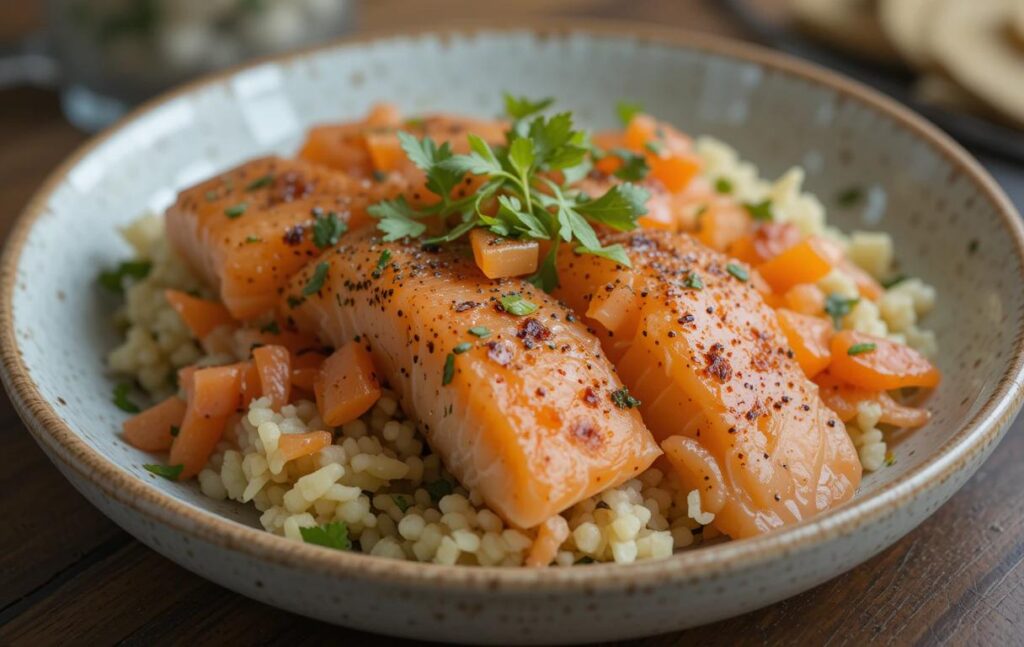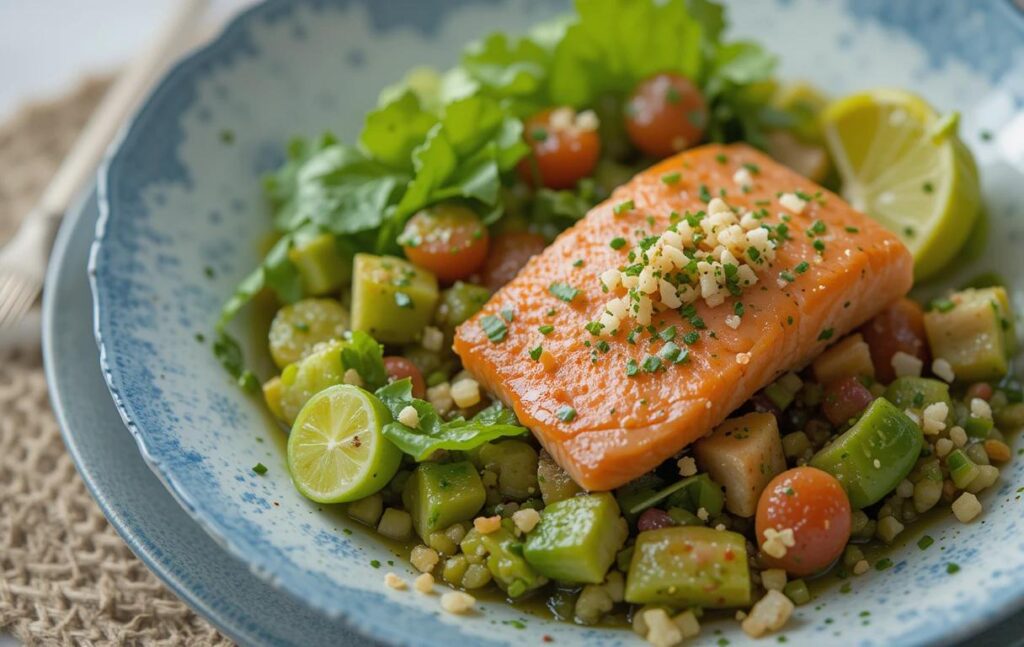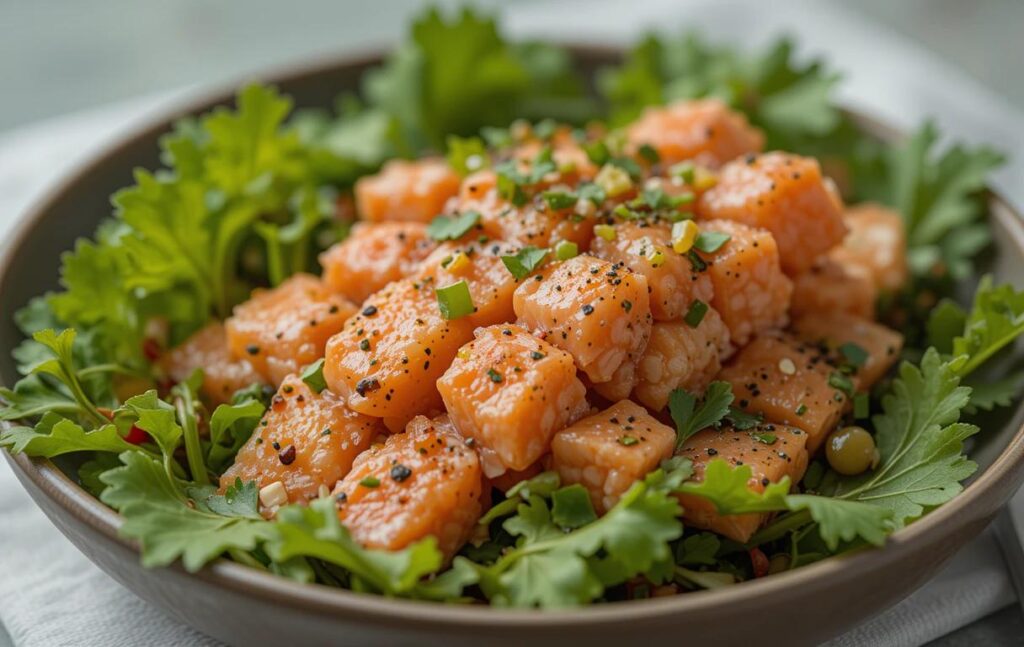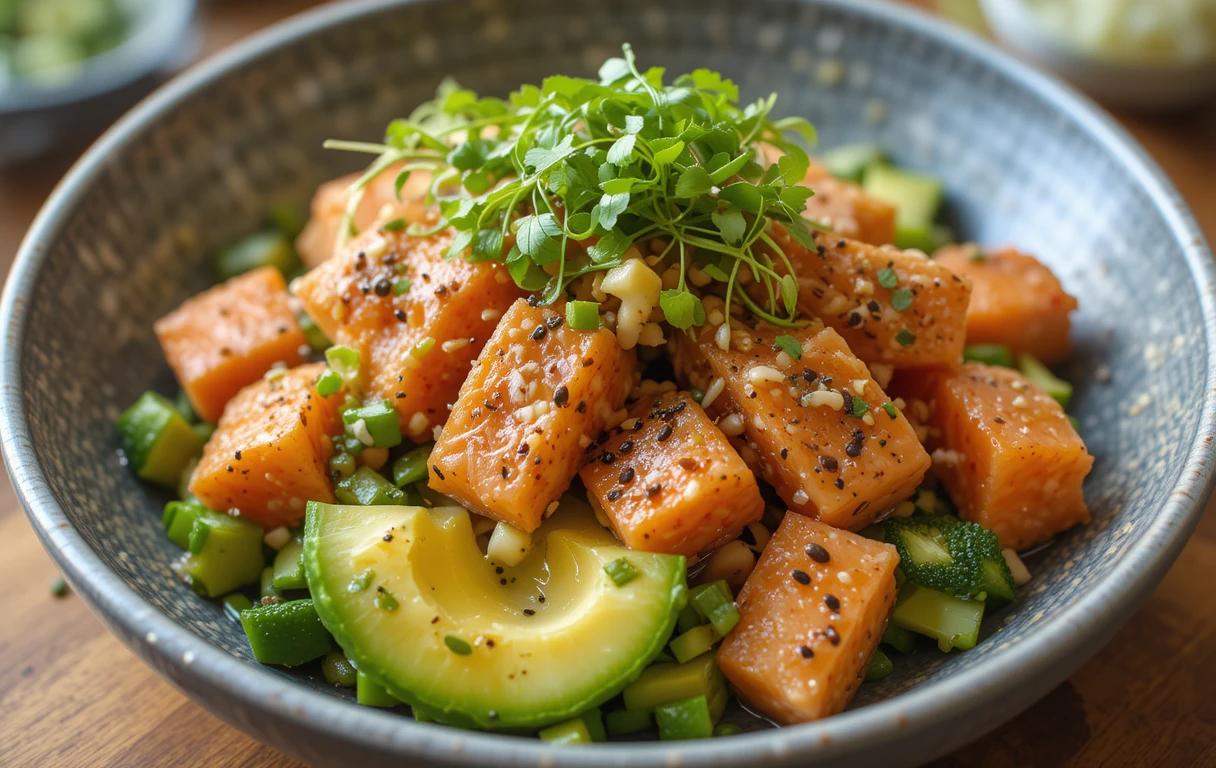salmon poke recipe
Salmon poke (pronounced poh-kay) is a traditional Hawaiian dish that has gained immense popularity worldwide for its refreshing flavors, vibrant colors, and healthy appeal. Rooted in Hawaiian culture, “poke” means “to slice” or “cut crosswise into pieces,” referring to the preparation of raw fish, typically seasoned with a blend of sauces, vegetables, and spices.
The salmon poke recipe is a modern twist on this classic dish, combining the delicate, buttery texture of fresh salmon with a medley of ingredients that enhance its natural flavor. It’s a versatile dish, often served as a light appetizer, a hearty salad, or a satisfying meal over steamed rice, known as a poke bowl.
Key elements of a great salmon poke include high-quality, sushi-grade salmon, fresh vegetables, and a balanced dressing that blends salty, sweet, and tangy flavors. Toppings like sesame seeds, green onions, and avocado add layers of texture and taste, making each bite a delightful experience.
Salmon poke is not only delicious but also easy to prepare, requiring minimal cooking and effort. Whether you’re new to poke or a seasoned fan, this recipe promises a delicious journey into Hawaiian-inspired cuisine. Perfect for summer evenings, casual gatherings, or a healthy midweek meal, salmon poke is as versatile as it is flavorful.
Ingredients and Preparation for Salmon Poke Recipe
Choosing the Right Salmon
The foundation of a great salmon poke recipe lies in selecting the right salmon. Here are some tips to ensure quality:
- Sushi-Grade Salmon: Always choose sushi- or sashimi-grade salmon, as it is safe to consume raw. Check with your local fishmonger or specialty grocery store.
- Freshness: The fish should have a bright, vibrant color and a clean, oceanic smell (not fishy).
- Storage: Keep the salmon refrigerated and use it as soon as possible to ensure maximum freshness.
Essential Ingredients for Salmon Poke
To create a delicious salmon poke, you’ll need the following ingredients:
- Sushi-Grade Salmon (about 1 lb): Cut into bite-sized cubes.
- Soy Sauce (2-3 tbsp): For a salty, umami flavor.
- Sesame Oil (1 tbsp): Adds a rich, nutty aroma.
- Rice Vinegar (1-2 tsp): Provides a tangy contrast.
- Sugar or Honey (1 tsp): Balances the salty and tangy flavors.
- Fresh Ginger (1 tsp, grated): Adds a spicy zing.
- Garlic (1 clove, minced): Enhances the savory notes.
- Scallions or Green Onions (2 stalks, sliced): For garnish and added freshness.
- Sesame Seeds (1 tbsp): Toasted for extra crunch.
- Optional Additions:
- Avocado: Cubed, for creaminess.
- Cucumber: Diced, for a refreshing crunch.
- Edamame: Shelled, for a protein boost.
- Seaweed Salad: For an authentic Hawaiian touch.
- Spicy Mayo: Made with mayonnaise and sriracha for a creamy kick.
- Base Options: Serve over steamed white or brown rice, quinoa, or mixed greens.
Preparing and Marinating the Salmon
- Prepare the Salmon:
- Rinse the salmon under cold water and pat it dry with paper towels.
- Using a sharp knife, cut the salmon into even, bite-sized cubes (about 1-inch).
- Make the Marinade:
- In a bowl, combine soy sauce, sesame oil, rice vinegar, sugar or honey, grated ginger, and minced garlic. Whisk until the sugar dissolves and the mixture is well-blended.
- Marinate the Salmon:
- Place the salmon cubes in a clean bowl.
- Pour the marinade over the salmon and gently toss to coat each piece.
- Cover the bowl with plastic wrap and refrigerate for 15-30 minutes to allow the flavors to meld. Avoid marinating for too long to preserve the salmon’s delicate texture.
- Assemble Your Poke Bowl:
- Place your base (rice, quinoa, or greens) in a bowl.
- Add the marinated salmon on top.
- Garnish with scallions, sesame seeds, and your favorite toppings like avocado, cucumber, or edamame.
This simple yet flavorful preparation is sure to deliver a fresh and satisfying poke experience!
Steps to Make Salmon Poke

Detailed Step-by-Step Instructions
- Prepare the Salmon:
- Ensure the salmon is sushi-grade and fresh.
- Rinse the fillet under cold water and pat it dry with paper towels.
- Place the salmon on a clean cutting board and remove the skin if necessary.
- Cut the Salmon:
- Using a sharp knife, slice the salmon into uniform bite-sized cubes (about 1-inch pieces). Uniformity ensures even marination.
- Prepare the Marinade:
- In a mixing bowl, combine the following:
- 2-3 tbsp soy sauce
- 1 tbsp sesame oil
- 1-2 tsp rice vinegar
- 1 tsp sugar or honey
- 1 tsp grated fresh ginger
- 1 clove garlic, minced
- Whisk until well-blended and the sugar or honey dissolves.
- In a mixing bowl, combine the following:
- Marinate the Salmon:
- Add the salmon cubes to the marinade.
- Toss gently to coat each piece evenly.
- Cover the bowl with plastic wrap and refrigerate for 15-30 minutes. Avoid over-marination to preserve the salmon’s delicate texture.
- Assemble the Bowl:
- Choose your base (steamed rice, quinoa, or greens) and place it in a serving bowl.
- Add the marinated salmon on top.
- Garnish with toppings like scallions, sesame seeds, avocado, cucumber, edamame, or spicy mayo.
- Serve and Enjoy:
- Serve immediately for the freshest flavor.
- Pair with a side of seaweed salad or miso soup for a complete meal.
Tips for Cutting and Handling Raw Fish
- Choose the Right Knife:
- Use a sharp, clean knife to make precise cuts without damaging the salmon’s texture.
- Keep Everything Cold:
- Work quickly and ensure the salmon stays chilled during preparation to maintain its freshness.
- Practice Hygiene:
- Wash your hands and all tools thoroughly before and after handling raw fish.
- Use separate cutting boards for raw fish and other ingredients to avoid cross-contamination.
- Inspect for Bones:
- Run your fingers over the fillet to check for pin bones and remove them with tweezers if necessary.
- Uniform Cuts:
- Cut the salmon into even pieces to ensure each bite has the same texture and flavor.
Creating the Perfect Marinade
- Balance the Flavors:
- Combine salty (soy sauce), sweet (sugar or honey), tangy (rice vinegar), and nutty (sesame oil) flavors for a balanced marinade.
- Add Aromatics:
- Fresh ginger and garlic enhance the marinade with subtle heat and savory depth.
- Optional Add-Ins:
- A touch of chili flakes, sriracha, or wasabi for spice.
- A splash of lime juice for additional tang.
- Adjust to Taste:
- Taste the marinade before adding the salmon, and adjust the seasoning if needed.
- Avoid Over-Marination:
- Limit marination time to prevent the salmon from becoming too soft or losing its natural flavor.
By following these steps and tips, you’ll craft a fresh, flavorful salmon poke that captures the essence of Hawaiian cuisine!
Serving and Presentation
Best Ways to Serve Salmon Poke

- Classic Poke Bowl: Serve over a base of steamed white or brown rice, quinoa, or mixed greens.
- Family-Style Platter: Arrange all components on a large platter, allowing guests to build their own poke bowls.
- Individual Cups: Present the poke in small bowls or glasses for appetizers at parties.
- Taco-Style: Use the marinated salmon as a filling for seaweed wraps or soft tortillas.
Garnishes for a Professional Look
- Sesame Seeds: Toasted black and white sesame seeds add a nutty flavor and visual contrast.
- Scallions: Thinly sliced green onions give a fresh, vibrant touch.
- Avocado Slices: Arrange fanned-out avocado slices for a creamy and colorful garnish.
- Microgreens: Delicate greens like cilantro or radish sprouts elevate the presentation.
- Seaweed: Add strips of nori or a small portion of seaweed salad for authenticity.
- Edamame: Scatter shelled edamame beans for a pop of green and protein.
- Pickled Ginger: Place a small pile of pickled ginger on the side for a zesty bite.
Pairing Salmon Poke with Drinks
- Light White Wines: Sauvignon Blanc or Pinot Grigio complement the delicate flavors of the salmon.
- Beer: Opt for a crisp lager or a fruity wheat beer.
- Cocktails: Pair with a refreshing mojito, gin and tonic, or sake-based cocktail.
- Non-Alcoholic: Sparkling water with a slice of lime, iced green tea, or a fruity mocktail are excellent choices.
Health Benefits of Salmon Poke
Nutritional Value of Salmon
- High in Omega-3 Fatty Acids: Promotes heart health and reduces inflammation.
- Rich in Protein: Helps with muscle repair and growth.
- Source of Vitamin D: Supports bone health and immune function.
- Low in Saturated Fats: A healthier protein option compared to red meat.
Benefits of Other Ingredients in the Recipe
- Soy Sauce: Provides a source of umami flavor and is low in calories.
- Sesame Oil: Contains healthy fats that support cardiovascular health.
- Rice Vinegar: Aids digestion and adds a tangy flavor without added calories.
- Avocado: Packed with healthy monounsaturated fats, fiber, and vitamins.
- Cucumber: Hydrating and low-calorie, it adds crunch and freshness.
- Edamame: High in plant-based protein, fiber, and essential nutrients like folate.
- Seaweed: Rich in iodine, essential for thyroid function, and low in calories.
Is Poke a Healthy Meal Choice?
Yes, poke is a healthy meal choice when made with fresh, wholesome ingredients. Here’s why:
- Balanced Macronutrients: Provides protein, healthy fats, and complex carbohydrates (when served with rice or quinoa).
- Rich in Vitamins and Minerals: Salmon and vegetables deliver essential nutrients.
- Low-Calorie Option: Poke can be light and satisfying, depending on portion sizes and toppings.
- Customizable: Can be tailored to dietary needs, such as low-carb, gluten-free, or vegan (using tofu instead of salmon).
Poke is a nutritious, flavorful, and versatile meal that fits well into a balanced diet. By incorporating fresh ingredients and mindful preparation, it can be both a delicious treat and a health-conscious choice!
FAQs: Six Common Questions About Salmon Poke

- Can I Use Any Type of Salmon for Poke?
- No, it’s essential to use sushi- or sashimi-grade salmon, as it is processed and handled safely for raw consumption.
- How Long Can I Store Leftover Salmon Poke?
- Ideally, consume salmon poke within 24 hours of preparation. If stored, keep it in an airtight container in the refrigerator.
- Can I Customize the Ingredients?
- Absolutely! Poke is highly versatile, and you can substitute or add ingredients like tofu, shrimp, mango, or spicy mayo to suit your taste.
- What Can I Use Instead of Soy Sauce?
- If you’re gluten-intolerant or avoiding soy, tamari or coconut aminos are excellent alternatives.
- Can I Serve Poke Cooked Instead of Raw?
- Yes, you can use cooked salmon if you’re not comfortable eating raw fish. The flavor profile remains delicious, though slightly different.
- Is Poke Suitable for Special Diets?
- Yes, poke can be adapted to fit various diets, including low-carb (using greens as a base), gluten-free (with tamari), or vegan (using tofu or marinated vegetables).
Conclusion: Summing Up – Why Salmon Poke is Perfect
Salmon poke is the ultimate combination of simplicity, flavor, and nutrition. Its roots in Hawaiian cuisine provide a cultural touch, while its adaptability allows it to fit seamlessly into any modern lifestyle. Whether you’re looking for a quick, healthy meal, an impressive dish for entertaining, or a new way to enjoy fresh seafood, salmon poke checks all the boxes.
This dish is not only visually stunning but also packed with health benefits from omega-3 fatty acids, fresh vegetables, and wholesome ingredients. With its vibrant flavors and endless customization options, salmon poke is perfect for anyone seeking a refreshing, satisfying, and nutritious meal.
Incorporate salmon poke into your menu and experience why this dish has become a global favorite—it’s a delightful journey of taste, texture, and tradition!
Related Recipes
- “Tuna Tomato Sauce Pasta Recipe“: A tomato-based recipe showcasing another way to use tomatoes.
- “Baked Chicken Fettuccine Alfredo with Broccoli“: Another comforting dish that can be complemented with tomato-based sauces.
Ingredient-Focused Content
- “Lions Mane Mushroom Recipe“: Suggest using a tomato gravy as a flavorful addition for plant-based dishes.
Cooking Techniques and Enhancements
- “Mango Habanero Salsa“: Explore complementary uses of sauces and gravies for flavor diversity.
Storage and Reuse Tips
- “Sous Vide Recipes“: Recommend tomato gravy as a sauce for sous vide-cooked meats or vegetables.
- “Ocean Spray Cranberry Sauce Recipe“: Guide readers on making and storing sauces, including tomato gravy.

